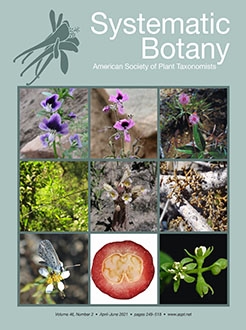Daniel L. Nickrent, Huei-Jiun Su, Ruo-Zhu Lin, Mohan Prasad Devkota, Jer-Ming Hu, Gerhard Glatzel
Systematic Botany 46 (2), 403-415, (11 August 2021) https://doi.org/10.1600/036364421X16231785234748
KEYWORDS: chloroplast, cladistics, deciduous, mitochondrion, phylogenetics, plastome, ribosomal RNA
The genus Loranthus (Loranthaceae) consists of ca. nine Old World species distributed from eastern Asia to Europe. Loranthus, the type of the family, has had a complex taxonomic history that continues today, partly because most mistletoes in the family have resided in this genus. For this reason, there are over 1800 Loranthus species names, the vast majority of which are synonyms for mistletoes in other genera. The present work sampled representatives of nine species considered bona fide members of the genus. Using complete plastome sequences, nuclear ribosomal DNA, and mitochondrial 26S rDNA, phylogenetic gene trees were generated to assess interspecific relationships. The Loranthus plastomes ranged in size from 121 to 125 kb and exhibited the quadripartite structure seen in most Santalales. These plastomes have lost or pseudogenized 24 genes, including all of the NADH dehydrogenase complex, thus reducing the genomes to ca. 90 functional genes. Cladistic analyses of morphological characters were conducted and these trees compared to the molecular trees, thus informing which taxonomic characters best define clades and characterize species within the genus. Two major clades in Loranthus were identified. The Europaeus clade includes the deciduous species L. europaeus, L. grewingkii, L. lambertianus, and L. tanakae mostly distributed above 30° N latitude. The Odoratus clade, mostly distributed below 30° N latitude, included L. guizhouensis, L. kaoi, L. odoratus, and L. pseudo-odoratus. The latter four species are genetically closely related, show percurrent (vs. pseudo-dichotomous) branching, and have evergreen leaves. Unisexual flowers have apparently evolved independently in each of the two clades. Future work should focus upon the species delimitation in the Odoratus clade and whether hybridization is occurring among any members.


